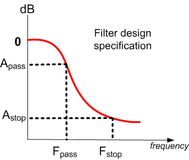Carry out the design by inputting the filter specifications using the sliders. There are five filter specification parameters

The plot at the top helps you see the locations of these parameters. These are standard digital filter design parameters that can be found in a number of digital signal processing textbooks.
You can do the design using normalized units ( to
) or in Hz. If you select normalized units,
then
corresponds to the Nyquist frequency and
and
will be between
and
.
Next select the analog-to-digital filter mapping method, which can be bilinear or impulse invariance.
Next select the order of the filter. You can select a minimum order to be designed or specify the order
yourself using the slider. The design supports a filter order up to . Finally, using the pulldown menu,
select the plot type.
Some inputs will become disabled or enabled depending on what you select for the filter order and for
the units. If you select a specific filter order, then only will be enabled, as
is not required in
this case; attenuation input is also disabled in this case, as attenuation
will be fixed at
db. If you select normalized units, then the slider
is disabled, as Nyquist is fixed at
.
The design status is displayed below the main display window. Two possible design errors are detected
and are displayed in red text. The first occurs if the filter order calculated is over (when you
select minimum filter order). In this case you need to change the design parameters until the
filter order becomes less than
. This error can occur if you select
much larger than
.
The second error occurs if the gain is found to be too small. This can occur if you select and
that are too close to each other.
A number of plots are made available to examine different aspects of the final design result, such as the
locations of the poles and zeros, the response of the filter to common test input signals, and the display of
and
in symbolic form.
Due to space limitations, the design is limited to a filter of order . You can get the design by asking
for a minimum order filter or by specifying the filter order required. Both normalized units and hertz units
can be used in the frequency specification.
References
A. V. Oppenheim and R. W. Schafer, Digital Signal Processing, Englewood Cliffs, NJ: Prentice-Hall, 1975, Chapter 5.